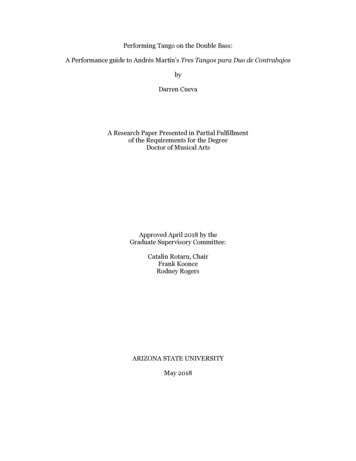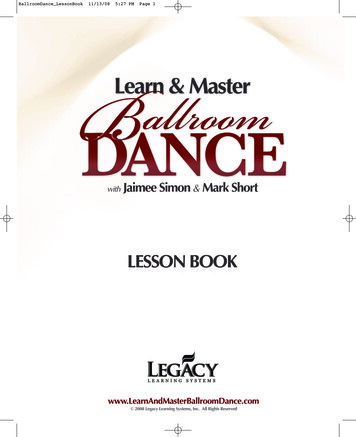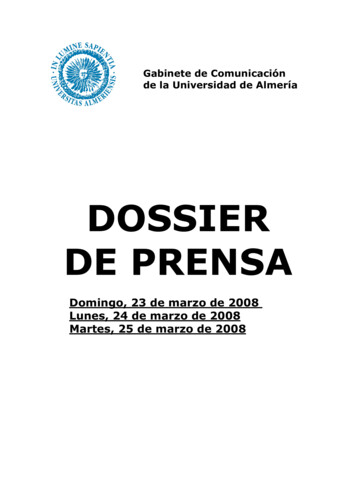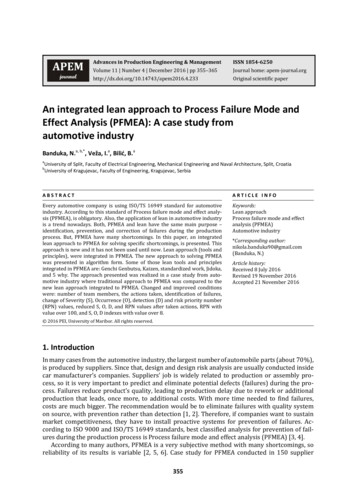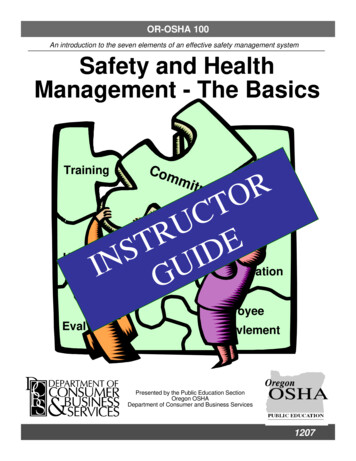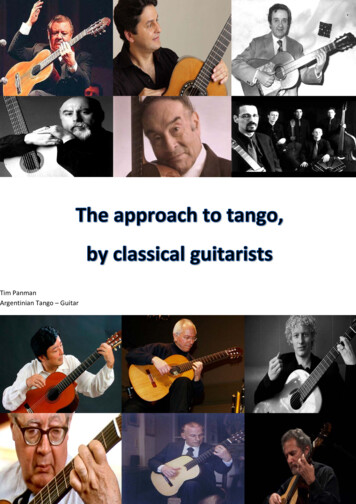
Transcription
Tim PanmanArgentinian Tango – Guitar
1
IntroductionSince I started to play tango music, I noticed that there were multiple technical andharmonical approaches to playing and studying a piece.When I started my studies here in the conservatory, I immediately noticed that my mainsubject lessons were divided in two parts. In the first part my teacher (Kay Sleking) would gothrough classical pieces (etudes) with me, and the second part of the lesson would be abouttango pieces.Of course, we were working on my technique by playing these pieces, but I also noticed thatmy overall playing was changing. Even my approach to the tango pieces changed, and Imanaged to implement my technical skills (obtained by the etudes) in the tango pieces.I came into this conservatory, having the very basic skills necessary to play tango andclassical. But what I did not have, was knowledge of, for example, the harmony, or tangovocabulary, or how to phrase.I was taught that knowledge about harmony for example, is essential for a tango musician tohave, especially as a guitar guitarist. This is the main reason that all people in the tangodepartment follow harmony and transcription lessons. In my opinion these lessons are thebest way to learn how harmonic structures in different pieces work.But this is not the only skill necessary. During my studies I was gradually looking for piecesthat were more difficult. I noticed that I needed to improve my technique to play thesepieces. This I did, by playing etudes, provided by my teacher.Out of interest, I started to look for virtuosic classical guitarists willing to show theirperception of tango. I found several, in real life, but also in videos and recordings. I noticedthat their approach to tango was totally different from the original, but certainly not in aninferior way!In my thesis, I want to elaborate and research the different approaches to tango pieces.Since this subject is way too elaborate, I will define my main question of my theses to thefollowing: What are the differences between a classical, and a tango guitarist, when playingtango?Of course, we will have to look closer to: what defines a tango guitarist? What defines aclassical guitarist? I want to analyze the differences by conducting research, doingtranscriptions, and interview my main subject teacher Kay Sleking, who (in my opinion) is theperfect example of tango and classical knowledge joining forces.2
Table of contents:1 ‐ The definition of a tango GuitaristPage 42 ‐ The definition of a classical guitarist?Page 53 ‐ Interview Kay SlekingPage 64 ‐ My experiment‐ Making recordings‐ Analysis of recordings‐ Agustín Carlevaro‐ Anibal Arias‐ Analysis of transcriptions‐ ConclusionPage 95 ‐ Differences in technique between tango and classical guitaristsPage 206 – Conclusion and reflectionPage 237 – Sources and appendixPage 253
What defines a tango guitarist?There are no sources from the outside available to define what a tango guitarist is. However,for this thesis I will clarify what is my perception of a tango guitarist. Someone who studied tango music under supervision of a renowned tango guitarist,or graduated from the tango department of CODARTS Rotterdam.One of the remarkable aspects of tango guitar is that the guitarists play with a plectrum(pua) on a classical guitar.The way tango guitarists interpret a solo arrangement is different than a classical approach.The experiment that I conducted will display more information about this interpretation.They have a specific way of playing the melody and harmony with typical elementsbelonging to tango (chromatic lines in the melody, appoyaturas, dissonants, phrasings, etc.).To define my opinion above, I will mention a few names of well known guitarists who earnedthe title of tango guitarist. More information about these guitarists will follow in the fifthchapter of my thesis.‐ Roberto Grela‐ Cacho Tirao‐ Anibal Arias‐ Hugo RivasThese guitarists changed the way tango was played on the guitar. This not only goes for soloplaying, but also in different formations.Some tango guitarists/instrumentalists spend a lot of time playing “a la parilla”. This is a wayof ensemble playing, in which everybody knows the melody and the underlying chordprogression. All the guitarists/instrumentalists get the opportunity to show their owninterpretation of the song by using different phrasings, embellishments and improvisations.Since the roots of the guitar within tango are that of accompaniment (singers,bandoneonists, violinists, etc.), this obviously is a major requirement for guitarists. Playingchords in multiple inversions, using harmonic changes and fills are the characteristics ofaccompaniment in tango music.Tango guitarists, when compared to classical guitarists, are more seen as arrangers, makingtheir very own version of a (well‐known) piece. This also counts for the otherinstrumentalists in tango.4
What defines a classical guitarist?For this question again, I will give my own opinion on what is a classical guitarist. Someone who has a degree in classical music, and/or studied under supervision of arenowned classical guitarist.Classical guitarists are trained to read sheet music into small detail and reproduce thewritten music as precise as possible. They have been educated in such a way that they tendto take everything that is written on paper very seriously.Also, classical guitarists have a different posture when playing. Their guitar has a diagonal,more upright position, and is positioned between their legs. Tango guitarists tend to havethe guitar horizontally on their right leg. To maintain theirposture, classical guitarists use an adjustable pedal under theirleft foot. To clarify, I will give a few names of famous guitariststhat changed classical guitar for ever. These are comparableguitarists from approximately the same timeframe.‐ Andres Segovia‐ Augustin Carlevaro‐ Kazuhito Yamashita‐ John WilliamsAndres SegoviaWhen listening to classical guitarists, they will define themselves by having a very round,polished tone. This is because they spent a lot of time refining their right hand, making surethe resistance of their nails, when playing a string, is minimal.For classical guitarists it is very important to have a nail treatment for the hand that plucksthe strings, that reduces the friction with the strings. Polishing and cutting the nail in thecorrect shape is vital.For classical guitar perfect technique and tone is very important. There are many researchesto the best way of using left and right hand technique.Classical guitarists are trained to play many styles, from renaissance to modern music. Allthese styles have their own dos and don’ts in the way of performing.5
Interview Kay SlekingShort biography:“Kay Sleking studied classical guitar at the Rotterdam conservatory. In the second phase ofthe conservatory, he specialized in Argentinian tango under the supervision of Argentinianguitarist, arranger and composer Coco Nelegatti. Kay graduated in the year 2000, got theESSO price for young musicians and became a teacher in the tango department of theRotterdam Conservatory.”Interview:Tim: Kay, you started as a classical guitarist, what made tango music so attractive for you?Kay: I started to play guitar as a 10 year old, and a lot of the classical repertoire I played wasfrom South‐America. Simple, but with rhythms and harmony that caught my attention. I alsoloved to play the standard classical repertoire of Scarlatti, Carcassi, Sor, Carulli, Bach, etc. Asa child your teacher hands you most of the sheet music, but after some time you develop apreference towards particular styles. For me this certainly was the music from South‐America, not only Argentinian music, but also music from Brazil or Venezuela (e.g. Villa‐Lobosor Antonio Lauro). I loved to study and play these rich southern melodic and harmoniccompositions. My first Argentinian pieces were more ‘touristic’ pieces, consisting of simpletango elements and leaning towards classical compositions, but it gave me so much fun! Myfirst real tango piece was Milonga Cardoso, composed by Jorge Cardoso. But before I playedthis composition I got to know a beautiful recording by the Assad brothers (guitar duo). Theyplayed the Tango Suite from Piazzolla and I was mesmerized by the music. I never heard acomposition like that before, so rich in harmony, rhythm and melody, a beautifulcombination of classical technique and jazz harmony. The Assad brothers are amazingguitarists, so they made the music come alive. This was my first experience with tango thatmade me become curious.In order to play repertoire like this you need good technical skills in combination with greatfeeling of rhythm, musicality and improvisation. This challenge was what made me fall inlove with tango.Tim: Before you started taking lessons from Coco Nelegatti, you must have played tangoyourself already. What were the first aspects of tango that you learned?Kay: In the time that I was studying classical guitar in the prepatory year in Amsterdam, I metCarel Kraayenhof (bandoneon player) and he told me he was going to start a tangodepartment in Rotterdam at the Worldmusic Department, together with Leo Vervelde(bandoneon player). I decided to quit my studies in Amsterdam and continue in Rotterdam.My main course was classical guitar and I participated in the Tango department. Via thisconnection I received tango sheet music and I also transcribed a lot of music, for example theFugata by Piazzolla. In that period I did not work with Sibelius or Finale but wrote everythingby hand, also the arrangements for duo, trio, etc. and the separate parts.6
In the beginning I started with listening to all kinds of recordings and later I started with animportant part in tango: arranging.What considers the transcribing of songs, at first I really didn’t know how to listen, or what tolisten to. And when I catched what happened, I didn’t know how to translate it into a score.But I managed by trying over and over.For the playing, my classical technique was already in good shape. Now I had to know how Icould translate the groove in a ‘not classical’ way. Lucky for me I met Coco Nelegatti (tangoguitarist). For me he is an example of tango groove in accompaniment and solo playing. Iliked so much the alternation between the warm and the percussive sound of the guitar.Also, the jazz treatment of harmony, the freedom in accompaniment and creativeness inmaking own arrangements. The exchange between accompaniment, playing lead andplaying solo arrangements/compositions makes tango for me incredibly interesting.Tim: Is classical technique something you need in tango?Kay: It depends on what you want. There are amazing tango guitarists that cannot read asingle note, but perform in a superior way. But these guitarists don’t necessarily play withfingers or multiple voicings, like classical guitarists .They often play with plectrum and don’tneed some of the classical techniques because they never use them. That’s a choice youmake as a tango guitarist: do you want to play porteno (old school), or do you want to go tothe modern way? Some guitarists can move in both worlds, like for example Cesar Angeleri.Tim: Which things were crucial to “cross the bridge” from classical music to tango music?Kay: One of the important facts for me was that, during, my classical studies, I learned toplay exactly what was written. I played compositions by Monteverdi to modern composers,which is a broad range. To my opinion you will never be able to play every style as it is reallymeant to be, unless you focus on particular styles, like for example Baroque music. Then youneed to go deeper into the culture and the way of performing this music. This way of thinkingyou need to obtain if you want to cross the bridge to tango. For tango you need to be able toplay a score as a solo or accompaniment with only melody and chords, so you need to knowabout harmony and phrasing melody. This is a different way of working to classical guitarists.As a classical guitarist you will have to let go of the score and play with less informationwritten down. For tango, there is a switch that needs to be flipped, and flipping this switch isa different process for everyone. Some people try to avoid flipping the switch by using theirvirtuosic skills on the guitar. At a certain point this resistance to let go of the score will stop,and one will ask himself: what really defines the foundation to play tango? What is it allabout? For me, the foundation in tango is rhythm. Rhythm is something that you need tofeel. The way to deal with rhythm in tango is totally different than in classical music. This isprobably the most important aspect where you need to cross over.7
Tim: Are there, in your opinion, pieces that lie in between both genres?Kay: A lot of classical musicians really want to play tango, but actually don’t go deep enoughinto the characteristics of the genre to be able to really master it. On the other hand, you alsohave skilled musicians who really know the genre, and choose to perform it from a classicalangle, like f. ex. Agustin Carlevaro. Yo‐yo ma for example, amazing cello player, magically tolisten to, what he plays is more a classical translation of tango than it is still a genre piece.The same goes for the Assad brothers, amazing to hear how they play, while they playScarlatti and Piazzolla in the same way. It’s actually a good thing that musicians like them tothis, so it attracts other classical musicians to get to know tango.On the other hand, somebody that knows the instrument, knows the melodies, but doesn’thave the background, and doesn’t really go deep into the music, will most likely become a“generalist” in tango, not one or the other.Then we have for example Gustavo Beytelmann, who mixes classical music, tango, and jazzin his very own, superb way.Tim: What could tango guitarists learn from classical guitarists, and the other way around?Kay: The term ‘tango guitarist’ is really broad, there is a lot of difference between the waymusicians play tango. Musicians like Hugo Rivas, or like Anibal Arias, or like JuanjoDominguez, or like Cacho Tirao, they all have their own unique style. To answer this questionwe need to look at how the genres work, how do the musicians study, what is their routineetc. As a classical guitarist you first focus on the old pieces, and then you try to reproduce thebeauty of the sound as closely as you can. You try to polish every note. As a tango guitarist, ifyou find a nice piece, the first thing that you will do, is to listen to different interpretations ofthe piece, played by guitarists or orchestras. If you do this a lot, after some time you willdevelop a certain taste for certain instrumentalists or orchestras. Then you can start tocreate something yourself, starting from a single melody line, and/or the matchingaccompaniment. This is more of a jazz approach.I would say tango already has taken a lot from classical music, beginning with the very firsttechnique methods for guitar. Without these studies, tango would look a lot different, and sowould classical music.Conclusion interview Kay SlekingKay is a guitarist who crossed the bridge from classical to tango. Crossing this bridgerequired some tools, rhythm‐wise, harmony‐wise and vocabulary wise. Kay already had apassion for South‐American guitar pieces. This obviously helped him harmony and rhythm‐wise, to cross the bridge to tango. Also, the fact that he had to make all the tangotranscriptions by hand gave him the possibility to develop his ears, and his knowledge aboutharmony. Kay really managed to create his own style within tango. His way of playing alsofeatures the polished technique of classical players. This, in combination with the way thattango music taught him how to arrange, makes Kay a good example of classical and tangomusic joining forces.8
My experimentIn this chapter, I want to deepen the subject of my thesis. I conducted a research amongstguitarists in the classical and tango fields that I know. I made them play a tango standard intheir own way, I made them give their perception of the piece.Also, I made transcriptions of a tango standard being played by a well‐known classicalguitarist, and the same piece played by a well‐known tango guitarist. We will have a look atwhat’s different, and try to catch their idea of the piece.For starters, I asked Alvaro Rovira Ruiz as a tango guitarist. Alvaro Graduated from thelatin/brazillian department, but he comes from Argentina, and he had lessons in tango there.I thoroughly value his opinion and his playing, and therefore I asked him to play for myresearch. Alvaro also plays the 7 and 8 string guitars (next to the usual 6‐string guitar), usedin Brazillian music, but also in tango.Secondly, I asked Lotte Brekelmans as a classical guitarist. Lotte did her bachelor in classicalin Tilburg, and her master in tango guitar here at CODARTS, but she still has a strong“classical” attitude in her playing. Her way of playing is still strongly influenced by herclassical education. She gives an approach to tango, that I am curious about, and therefore Iwant to incorporate her playing in my thesis.The piece that is played by the abovementioned people will be “la casita de mis viejos”, fromJuan Carlos Cobian. The arrangement was made by Edgardo Acuna. I gave all of themsomething to start from, and told them to make their own arrangement. I will include thisarrangement in the appendix.Making your own arrangement in tango is so important, it defined almost every famousinstrumentalist in the history of tango.We will now analyze the final recording that I made with Alvaro, of him playing his version of“la casita de mis viejos”.An important noteThe classical guitarists that contribute to my research all have an idea of how tango shouldwork, and they have all been in touch with the music before. I approve of this, because if youwant to improve your vision on a certain music style, you will have to listen to it, anddevelop some sort of taste. In my opinion, classical guitarists that understand tango musicbut still approach it in a classical way are perfect for my research. Therefore, the researchsubjects in my thesis will have the abovementioned experience.9
Points of interest In Alvaro’s recording:I told Alvaro to make his own arrangement/version of the piece, and he didn’t even use thesheet music of the basic piece that I sent him.0:22: Use of a passing bass tone (G#) to go back to the tonic0:25 – 0:28: Dropping bass line(A – G – F – E)0:33 – 0:37: Melodic variation to emphasize the return to the I0:41 – 0:45: Chromatic bass line downwards (G# to E), followed by a G#, to create moredominant pressure0:54 – 0:56: Chromatic melody line to indicate the switch to A major1:34 – 1:52: Improvised interlude, a tool to go to a higher register1:53 – 2:01: Strong phrasing and free playing, harmony also really high2:02 – 2:03: Jumping an octave down by using the same notes an octave lower2:10 – 2:15: A set of diminished chords going up, to reach the high register again2:16 – 2:21: Playing the melody with a tremolo technique2:32: Using the ring, middle and index finger (in that order) to make a rasgueado, anduse it to play the melody2:44 – 2:51: Playing a different bass note every beat, mostly this is the original chord, with analternating bass, but sometimes Alvaro uses inversions3:04 – 3:07: Changing the chords a little: instead of D major and F#7 Alvaro plays Dmaj7, andF#7#5.3:22 – 4:09: Improvised outro, with incorporation of some parts of the melodyShort summary of overall typical points in the recording:‐ melody in different octaves‐ a lot of tempo changes‐ frequent phrasing‐ switching positions during the piece‐ using embellishmentsPoints of interest in Lotte’s recording.I told Lotte that she should make her own arrangement/version of “la casita de mis viejos”,but she chose to stick very close to the arrangement that I gave her.0:04: Chord playing (not arpeggiated)0:05 – 0:23: Steady tempo, clearly designating harmonic changes by playing the chordsunder the melody.0:28 – 0:30: Playing a fifth of the dominant in octaves up0:38 – 0:42: Playing Ponticello (close to the bridge of the guitar)0:46 – 0:50: Lotte plays this a tempo, this is an opinion based matter, in the original this parthas a rallentando and consecutively an accelerando0:52 – 0:54: Partial scale played upwards to indicate the switch to A major1:18 – 1:21: Lotte places the accent on the last 8th beat of both of the bars1:26: Tonic of the dominant chord (E7) played in octaves1:46 – 1:55: Phrasing by use of triplets10
1:56 – 1:57: Lotte plays A minor 9, and puts this 9 in the middle of the chord register as adissonant2:11 – 2:12: Playing this chord in the first position2:42 – 2:44: Playing a staccato bass‐line2:53 – 2:54: These are two lines, one descending, one staying on the E, Lotte puts the accenton the upper E (the one that stays).3:10 – 3:11: Lotte plays a chromatic line to an F#, in the original this was an F.Short summary of overall typical points in the recording:‐ melody in one octave‐ steady tempo‐ playing rubato‐ Lot of playing in the 1st position of the guitarWe can already draw a conclusion from this. Even though Lotte studied tango for 2 years,she still has a completely different way of playing the pieces. Her vocabulary within the pieceis limited compared to that of Alvaro, but also in some points completely different. Lottetreats this tango piece as if she is (still) playing a classical piece!Analysis of the recordings of Lotte and AlvaroFor starters, let’s see what similarities the recordings have.‐ They both play the same structure of the piece (A part, B part etc.)‐ They both play the piece in the same keyThat’s about it for the similarities. Of course the recordings are completely different, butlet s make an analysis of the things that are different.Lotte clearly studied the piece very well, there is no hesitation, and the choices she madeclearly reflect in her playing. She follows the sheet music very precisely. Alvaro has thetendency to try a lot of new things on the spot, also during concerts. In this case it workedout well for him.From these recordings we can derive some conclusions:‐ Both guitarists stuck to their comfort zone, Lotte stayed close to the sheet music, andAlvaro trusted his sense of harmony‐ Lotte played this piece like she would play a piece of, for example, Bach: clear articulation,a little rubato, focusing on the tone‐ Alvaro tried to remember the lyrics, and the harmony matching with those lyrics, then headds a lot of embellishments, appoyaturas etc. He tries to enrich the harmony.These are the typical ways that both styles work, classical guitarists focus on what is on thepaper, and tango guitarists also focus on what is not!11
Agustín CarlevaroCarlevaro was born on January 6th 1912 in Montevideo. Agustín and his brother Abel startedtheir classical music studies at seven years old, under the supervision of Pedro Vittone.Eventually, the two brothers chose their own direction within guitar music. Abel chose to bea classical musician and studied further with maestro Heitor Villa‐Lobos. Agustín becameaffiliated with the tango music, and started to write a lot of tango arrangements. Agustínreleased his first line of arrangements in 1963. He became really famous in Uruguay forbeing the best solo guitarist and making tango arrangements. In 1972, Agustín recorded aseries of records with different labels. Still, his style of playing remained very classical, wecan derive this from some recordings that we will listen to. Although Agustín is a well‐knownguitarist amongst classical guitarists, it was very hard to find substantial information abouthim.12
Anibal AriasAnibal Arias was born on July 20th, 1922 in Buenos Aires. H started to play the guitar at thevery young age of four. At ten years old, he started his guitar studies under the supervisionof Pedro Ramirez Sanchez. Besides being teacher and student, Anibal and Pedro becamegood friends, and Pedro would be one of the reasons of the success that Anibal was going tohave. He also studied a lot of classical music, through which he obtained amazing technicalabilities. In 1940 he started a series of concerts with classical music, but soon he realizedthat he was drawn more towards the tango music. In the same year he completely switchedrepertoire, and had his first professional performance with Angel Reco, a tango singer withwhom he would tour a lot. Anibal played the music of tango in a lot of formations with otherguitarists, but also as a soloist in cinemas. Between 1969 and 1975 Anibal Arias played withbandoneon player Anibal Troilo, one of tango’s most famous musicians. Anibal Arias startedas a classical guitarist, and used all the technical abilities that he obtained within the tangomusic that he plays. He made a lot of arrangements, each of them speaking the clearlanguage of tango. Anibal Arias died on October 3rd in Buenos Aires.13
Analyzing the recordings of Anibal Arias and Abel Carlevaro.I made transcriptions of both Anibal Arias and Abel Carlevaro playing the same piece: FloresNegras, a piece by Francisco de Caro. Both transcriptions will be provided with the thesis.Immediately I noticed a few things from these transcriptions:‐ The transcription of Arias is more dense, more notes are played over the entire range thatthe guitar has to offer‐ Carlevaro works a lot with 2 voices, a thing that happens a lot in classical guitar pieces fromSor or Guilliani‐ Both guitarists play in a different key, Arias playing in the original key, C major, andCarlevaro playing in E major, maybe part of his arrangement?What I noticed is that Carlevaro’s way of playing is more open, and that Arias’ way of playingis denser. He likes to make chords with 4 or more notes at the same time when he does so.It’s still quite unclear for me why Carlevaro chose the key of E major for his arrangement. Iguess he could have done this so that he has four sharps in the major part, and no sharps inthe minor part. For the piece of Arias, this is the other way around. But also, I can clearlyexplain why Arias chose this tonality. In his way of playing, he likes to play in the firstposition a lot, and use some of the open strings available. This creates chords that can bemore elaborate, denser.Both guitarists use more or less the same harmonic structure.Let’s take a look at how both guitarists open the piece:1)Agustín CarlevaroAnibal AriasAlready the upbeats in the first bar are different in timing. Why? Because the upbeat ofCarlevaro is played in the normal timing (straight), and the one from Arias is phrased(fraseo). These notes are colored in red.From the last beat of bar 2, to bar 3, Carlevaro changes the bass note from F to F# as apassing tone. Arias uses the chords Edim – G7, very nice harmonic choice, every time thechord changes, some notes from the previous chord stay. These notes are colored in blue.14
In bar 5 there is almost an entire bar empty, this means that there is room for interpretation.Let’s see what both guitarists did from bar 5 to bar 6:2)Agustín CarlevaroAnibal AriasCarlevaro choses here to create a syncopating bass‐line from B, to G#, which is the first bass‐note in bar 6. On top of that, the melody is also syncopated. These notes are colored in red.Arias plays a Dm/F chord, followed by a fill on that chord in the first half of the bar (red).Then a line upwards, the A# note in this line is just a fill‐up for the two neighboring B notes(blue).Then he closes the bar by playing a scale up to the Fmaj7b5 chord in the next bar(green).The next interesting part occurs from bar 7 to bar 9:3)Agustín CarlevaroAnibal AriasCarlevaro starts bar 7 in G#m , then uses a chromatic line downwards, and a scale upwardsin the transition to bar 8 (red). Doing so, he creates an F# chord (blue). In the second half ofbar 8 Carlevaro uses some sort of an appoyatura, he creates the harmonic feeling of F goingto F#7 (green), which in turn leads to the B major chord in the next bar (purple).In bar 9 Carlevaro shifts from B major to B7 (yellow), and closes the bar with some add‐onsto this chord.15
Arias starts off with bar 7 in Am, then goes to D/F# in bar 8, in the second half he uses a #11(red). In bar 9 Arias uses the G7 chord, and plays a fill, first from G to F (blue), and then fromB to A (green), featuring the D#, the #5 in this chord.Closing the A part.Bars 15 – 174)Agustín CarlevaroAnibal AriasCarlevaro puts the focus of bar 15 on the dropping melody line. He emphasizes this line byputting the matching dominant chords underneath (red). This creates a dropping line of E7 –D7 – C#7. Then Carlevaro plays the C – C# notes (blue) as a decoration to go to A major,which is the first chord of the next bar. The first two beats of this bar is the melody,supported by the A major chord (green). Then the last two beats of this bar are used by theA#dim and B7 chords (purple). Both of the chords have a C# and G# on top, this gives thechromatic bass line underneath (A# ‐ B) a nice character. In bar 17, Carlevaro closes the Apart by playing the an inversion of E major (Emajor/G#)Arias starts bar 15 with a very elaborate Am7/E chord, using all the strings of the guitar (red).Then, in the second half of the bar he plays an A7 chord, followed by a line from G to A, as adecoration to the first two beats of the next bar (blue). These beats in bar 16 all havedifferent notes, but the notes that are played all together resemble the Dm7 chord (green).Then, in the last two beats of bar 16, Arias goes from Am7 to G7, by using a chromatic dropin the bass line (A – G# ‐ G) (purple). Then, in bar 17, of course, the tonic of the major part isplayed to close it down.Interesting about this part is, that Carlevaro perceives the first half of bar 16 as major (Amajor), while Arias perceives it as minor (Dminor7).16
For classical guitarists it is very important to have a nail treatment for the hand that plucks the strings, that reduces the friction with the strings. Polishing and cutting the nail in the correct shape is vital. For classical guit
